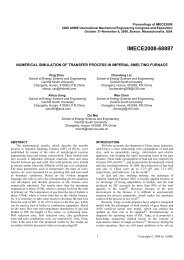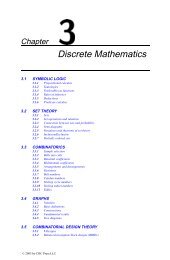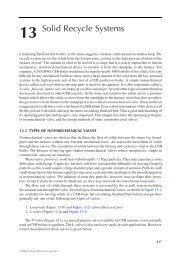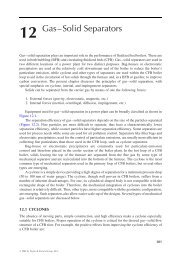Chapter 4: Geometry
Chapter 4: Geometry
Chapter 4: Geometry
You also want an ePaper? Increase the reach of your titles
YUMPU automatically turns print PDFs into web optimized ePapers that Google loves.
(a) The area of the ellipse is<br />
<br />
¾<br />
Ô Ô<br />
½ .<br />
¾ <br />
¾<br />
(b) The ellipse has the parametric representation x´Øµ Ó״صv ½ ·×Ҵصv ¾ .<br />
(c) The rectangle with vertices ´¦v ½ ¦v ¾ µ is tangent to the ellipse.<br />
3. A rational parametric representation for is given by<br />
½ ؾ<br />
½·Ø ¾<br />
4. The polar equation for in the usual polar coordinate system is<br />
Ö <br />
¾Ø<br />
<br />
.<br />
½·Ø ¾<br />
<br />
Ô<br />
¾ ×Ò ¾ · ¾ Ó× ¾ (4.6.12)<br />
With respect to a coordinate system with origin at a focus, the equation is<br />
Ö <br />
Ð<br />
½ ¦ Ó× (4.6.13)<br />
where Ð ¾ is half the latus rectum. (Use the · sign for the focus with<br />
positive Ü-coordinate and the sign for the focus with negative Ü-coordinate.)<br />
5. Let È be any point of . The sum of the distances È and È ¼ is constant<br />
and equal to ¾.<br />
6. Let È be any point of . Then the rays È and È ¼ make the same angle<br />
with the tangent to at È . Thus any light ray originating at and re ected<br />
in the ellipse will go through ¼ .<br />
7. Let Ì be any line tangent to . The product of the distances from and ¼ to<br />
Ì is constant and equals ¾ .<br />
8. Lahire’s theorem: Let and ¼ be x ed lines in the plane, and consider a<br />
third moving line on which three points È , È ¼ , and È ¼¼ are marked. If we<br />
constrain È to lie in and È ¼ to lie in ¼ , then È ¼¼ describes an ellipse.<br />
4.6.4 ADDITIONAL PROPERTIES OF HYPERBOLAS<br />
Let be the hyperbola with equation Ü ¾ ¾ Ý ¾ ¾ ½, and let<br />
¼ ´¦ Ô ¾ · ¾ ¼µ (4.6.14)<br />
be its foci (see Figure 4.17). The conjugate hyperbola of is the hyperbola ¼ with<br />
equation Ü ¾ ¾ · Ý ¾ ¾ ½. It has the same asymptotes as , the same axes<br />
(transverse and conjugate axes being interchanged), and its eccentricity ¼ is related<br />
to that of by ¼ ¾<br />
· ¾ ½.<br />
© 2003 by CRC Press LLC










